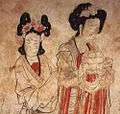Tomb of Wang Chuzhi

The Tomb of Wang Chuzhi (Chinese 王處直墓 / 王处直墓 Wang Chizhi mu) is the grave of Wang Chuzhi (863-923 CE), a senior military governor of the late period of the Tang Dynasty and the Later Liang from the time of the Five Dynasties. It was rediscovered in 1980 in Xiyanchuan village in Quyang district of the Chinese province of Hebei.
The grave was robbed in July 1994 because of the high artistic level of its wall paintings and reliefs which are of great historical value.
Painted marble relief
Painted on two marble reliefs, a group of servants and a fifteen-member ladies' orchestra.[1] It provides information about the musical tastes of the upper classes during the late Tang Dynasty.
Women's orchestra
There are twelve people in the orchestra. In the front row there are five women (from right to left) playing the konghou 箜篌 (bow harp), the guzheng 古箏 (an 18 - 23-stringed plucked zither with moveable bridges), pipa 琵琶 (lute), paiban 拍板 (bamboo clapper) and dagu 大鼓 (bass drum) while, in the back row, there are seven women playing the sheng 笙 (mouth organ), fang xiang 方響 (Chinese metallophone), dalagu 答臘鼓[2] (West Asian cylindrical drum)[3] two bili 篳篥 (oboes), and two hengdi 橫笛 or dizi 笛子 (bamboo transverse flutes)[4] At the far right of the front row is a male conductor with two young dancers in front of him.
Gallery
-

Epitaph of the tomb of Wang Chuzhi
-

-

-

-

-

-

-

-
_1.jpg)
-
_4.jpg)
-
_3.jpg)
-
_2.jpg)
-
_5.jpg)
-
_6.jpg)
Footnotes
See also
References
- Hebei Sheng Wenwu yanjiusuo 河北省文物研究所: Wudai Wang Chuzhi mu 五代王处直墓. Beijing: Wenwu chubanshe 1998, ISBN 7-5010-1035-8
- Zeng Jinshou. China's music and music education in cultural exchanges with neighboring countries and the West. Bremen 2003 (Diss) (Online, see: "Qiuci ji")
- Scots Hammer, Angela: "The grave of Wang Chuzhi (863-923)." In: Angela Scots Hammer (ed.) On the trail of the afterlife. Chinese culture grave in the facets of reality, history and cult of the dead. Frankfurt am Main: Peter Lang, 2003. pp. 61–117.
- Xiaoneng Yang (ed.): The Golden Age of Chinese Archaeology. Celebrated Discoveries from the People's Republic of China. ISBN 0-300-08132-4.
External links
- Angela Schottenhammer: Tombs of the upper classes in Ancient China: The grave of Wang Chuzhi (863-923)
- The Transformation of Medieval Chinese Elites (Nicolas Olivier Tackett)
- Wang Chuzhi mu
- Caihuishi sanyue fudiao - Chinesisch